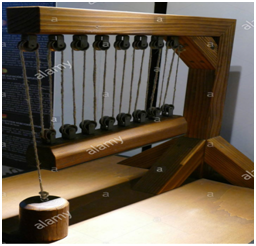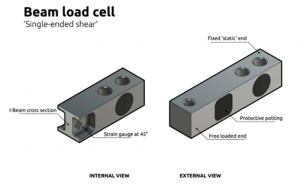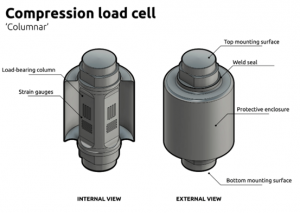A Load Cell is a particular kind of transducer or sensor which converts force into a measurable electrical output. Your typical load cell device consists of four strain gauges in a wheatstone bridge configuration. In an industrial scale this conversion consists of a load being transformed into an analog electrical signal
Leonardo Da Vinci used positions of calibrated counterweights on a mechanical lever to balance and determine unknown weights. Variation of his designs used multiple levers, each of a different length and balanced with a single standard weight. Before hydraulic and electronic strain gauge load cells replaced mechanical levers for industrial weighing applications, these mechanical lever scales were widely used. They were used to weigh everything from pills to railroad cars and did so accurately and reliably provided they were properly calibrated and maintained. They involved the use of a weight balancing mechanism or the detection of the force developed by mechanical levers. The earliest, pre-strain gage force sensors included hydraulic and pneumatic designs.
In 1843, the British physicist Charles Wheatstone devised a bridge circuit that could measure electrical resistances. The Wheatstone bridge circuit is ideal for measuring the resistance changes that occur in strain gages. Although the first bonded resistance wire strain gage was developed in the 1940s, it was not until modern electronics caught up that the new technology became technically and economically feasible. Since that time, however, strain gages have proliferated both as mechanical scale components and in stand-alone load cells. Today, except for certain laboratories where precision mechanical balances are still used, strain gage load cells dominate the weighing industry. Pneumatic load cells are sometimes used where intrinsic safety and hygiene are desired, and hydraulic load cells are considered in remote locations, as they do not require a power supply. Strain gage load cells offer accuracies from within 0.03% to 0.25% full scale and are suitable for almost all industrial applications.
How does it work?
Load cell designs are classified according to the type of output signal generated (pneumatic, hydraulic, electric) or according to the way they detect weight (compression, tension, or shear) Hydraulic load cells are force -balance devices, measuring weight as a change in pressure of the internal filling fluid. Pneumatic load cells also operate on the force-balance principle. These devices use multiple dampener
chambers to provide higher accuracy than can a hydraulic device. Strain-gage load cells convert the load acting on them into electrical signals. The gauges themselves are bonded onto a beam or structural member that deforms when weight is applied.
Post time: May-06-2021




